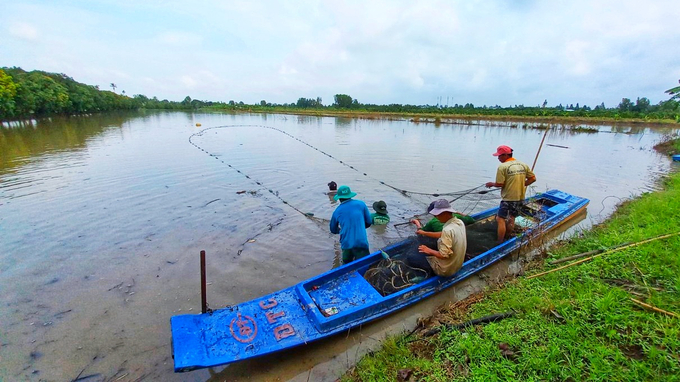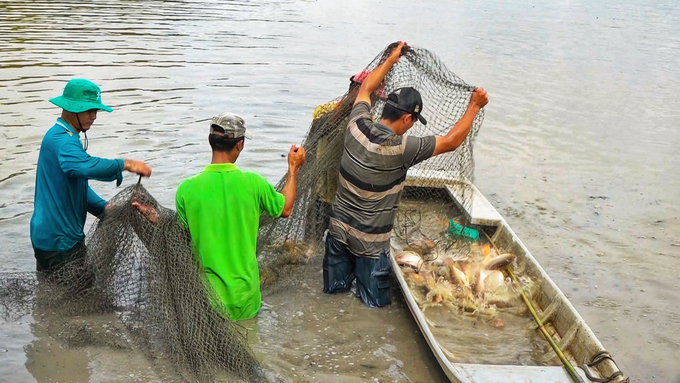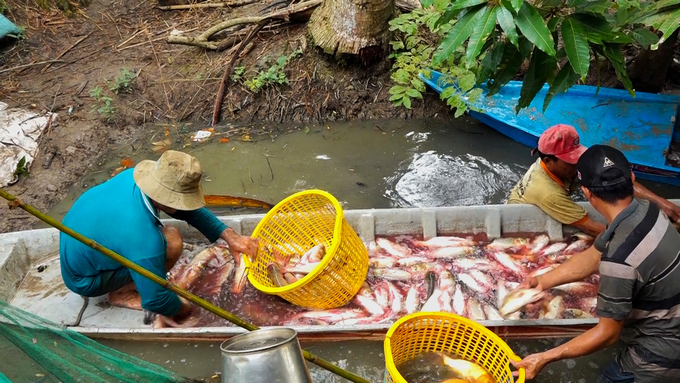November 7, 2025 | 22:33 GMT +7
November 7, 2025 | 22:33 GMT +7
Hotline: 0913.378.918
November 7, 2025 | 22:33 GMT +7
Hotline: 0913.378.918
Fish farming in rice fields during the flood season has become a sustainable livelihood model preferred by many farmers in the Mekong Delta in recent years.

Fish farming in rice fields during the flood season has become a sustainable livelihood model preferred by many farmers. Photo: Kim Anh.
With the increasingly high fertilizers and agricultural inputs' prices, the 3rd crop of rice has yielded low profit. For the last two years, every time the flood season arrived, Mr. Vuong Van Ngan's family in Truong Hoa hamlet, Truong Long A commune, Chau Thanh A district, Hau Giang province switched to fish farming in the rice fields. Mr. Ngan believes that the advantage of this model lies in the fact that it allows the soil to rest, form silt and nutrients; farmers can also save the cost of fertilizers and pesticides for the next crop. Moreover, fish farming in the rice fields is relatively simple: set up the net around the perimeter of the rice fields and then release the fish; there is no cost for feed, and compared to rice farming, the profit is much higher.
His family invested over 125kg of fingerlings, including carp and catfish for the current crop. Thanks to natural food sources in the field, the fish grew quickly. In preparation for the 2022-2023 winter-spring rice crop, his family is focused on harvesting more than 2 hectares of field fish. In addition, he also harvested other natural resources including snakehead fish, perch, gourami, rasbora, snails, etc. His income has subsequently increased significantly.

Harvesting rice field fish in Truong Long A commune, Chau Thanh A district, Hau Giang province. Photo: Kim Anh.
Mr. Ngan estimates that the price of fish is currently increasing by 4,000 to 5,000 VND/kg compared to the same period last year. With a harvest of nearly 9 to 10 tons of fish including field fish, he can potentially earn up to 20 million dong in profit. Mr. Ngan firmly believes that he will continue to develop this fish farming model for the flood season of the following year.
The strength of fish farming in rice fields in Truong Long A commune, Chau Thanh A district lies in the input seed supplier as well as guaranteed purchase of output. According to a contract signed with fish farmers, Ms. Nguyen Tuyet Hoa, a trader in Giong Rieng district, Kien Giang province, prepares a boat to travel to Hau Giang province to purchase fish at the beginning of every winter-spring crop.
“The price of fish is high this year so farmers are making a lot of profit. A farmer can raise 5kg of fingerlings on average. For a successful season, a farmer can harvest several hundred kilograms of fish meat. This year, flood water is in abundance, so the fish are quite heavy", said Ms. Hoa.

The model of fish farming in rice fields only requires investment in seed, farmers earn tens of millions of dong per hectare in profit. Photo: Kim Anh.
On average, Ms. Hoa's boat purchases several tons of fish meat daily, with the lowest ranging from 700 to 800kg. According to Ms. Hoa, the quality of field fish is premium, so the price is good, and the fish are completely clean because they are raised naturally.
Truong Long A commune reportedly has rougly 20 households that develop their economy based on rice field fish farming model. This is a new model, but the practical effects that it brought to farmers in the commune are positive. This model is suitable and adaptable to climate change conditions. As a result, fish farming in rice fields will be a livelihood model encouraged by the functional sector of Truong Long A commune to develop in the immediate future.

The livelihood model of fish farming in rice fields helps to improve the land and clean the fields in preparation for the winter-spring crop. Photo: Kim Anh.
Mr. Tran Van Dung, Vice Chairman of Truong Long A Commune People's Committee analyzed that during the flood season of 2022, most farmers in the commune abandoned their fields. A few farmers decided to implement a model of fish farming in the rice fields and achieved high economic efficiency. Compared to profits from rice production, Mr. Dung said that the profit from fish farming rice fields is higher on average; farmers earn a profit of nearly 2 million dong for every plot of land.
“In the past, the dike system was not enclosed, so it was difficult to raise fish in the field. When the irrigation system has been thoroughly developed, farmers are aware of protecting individual and collective dikes to raise fish. Truong Long A commune will cooperate with households providing quality seed, as well as households purchasing fish for meat. On the other hand, the commune will sign a contract with the Commune People's Committee to encourage farmers to participate and develop the field fish farming model", said Mr. Dung.
According to the Hau Giang province Sub-Department of Fisheries, the model of farming fish in rice fields or intercropping two rice crops and one fish crop has grown developed strongly in the province since 2019, with the most prominent models in the districts of Long My, Vi Thuy, Chau Thanh A. The conversion from rice cultivation in the third crop to fish farming in the field nearly doubles the economic efficiency compared to specialized rice cultivation. In addition, this livelihood model also helps to improve the soil and clean the fields in preparation for the winter-spring crop.
As of August 2022, the total area of aquaculture in Hau Giang province reached over 8,200 hectares. The total seafood production is estimated at over 40,800 tons. The total aquaculture area reached over 543 hectares in August, with an estimated output of at least 9,100 tons.
Translated by Nguyen Hai Long
/2025/11/07/0913-0-160253_450.jpg)
(VAN) Minister Tran Duc Thang called on FDI enterprises to strengthen linkages, promote green growth, and share benefits with Viet Nam.

(VAN) Vinamilk makes a notable impression at the Asian Technology Excellence Awards 2025 with two pioneering technologies in milk production.

(VAN) Vinachem reviews its 2021–2025 science, technology, and digital transformation progress, and share its vision for the 2026 - 2030 period.

(VAN) Scientists and policymakers say biotechnology, digital transformation, and organic farming are key to helping Vietnam’s coconut industry adapt to climate change and enhance sustainable export value.

(VAN) Combined with fierce competition from other coconut-producing countries and limited adoption of modern techniques, the Mekong Delta’s coconut sector faces an urgent need for transformation.
/2025/11/05/3030-3-092207_368.jpg)
(VAN) Can Tho has advantages to become the regional hub for diversified fisheries development, gradually establishing a sustainable value chain linked to deep processing and export.

(VAN) To contribute to the new rural development program, Quang Ngai is focusing on developing OCOP products in a more in-depth and sustainable manner.